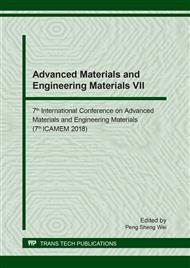[1]
Rajurkar KP, Sundaram MM, Malshe AP. Review of electrochemical and electrodischarge machining. Procedia Cirp. 2013 Jan 1; 6:13-26.
DOI: 10.1016/j.procir.2013.03.002
Google Scholar
[2]
Rajurkar KP, Zhu D, McGeough JA, Kozak J, De Silva A. New developments in electro-chemical machining. CIRP Annals-Manufacturing Technology. 1999 Jan 1;48(2):567-79.
DOI: 10.1016/s0007-8506(07)63235-1
Google Scholar
[3]
Kai S, Sai H, Kunieda M, Izumi H. Study on electrolyte jet cutting. Procedia CIRP. 2012 Dec 31;1:627-632.
DOI: 10.1016/j.procir.2012.05.011
Google Scholar
[4]
McGeough, J. A., 1988, Advanced Methods of Machining, Chapman and Hall.
Google Scholar
[5]
Davydov AD, Volgin VM, Lyubimov VV. Electrochemical machining of metals: fundamentals of electrochemical shaping. Russian journal of electrochemistry. 2004 Dec 1;40(12):1230-1265.
DOI: 10.1007/s11175-005-0045-8
Google Scholar
[6]
Hocheng H, Sun YH, Lin SC, Kao PS. A material removal analysis of electrochemical machining using flat-end cathode. Journal of Materials Processing Technology. 2003 Sep 22;140(1):264-268.
DOI: 10.1016/s0924-0136(03)00791-x
Google Scholar
[7]
Walther B, Schilm J, Michaelis A, Lohrengel MM. Electrochemical dissolution of hard metal alloys. Electrochimica Acta. 2007 Oct 10;52(27):7732-7737.
DOI: 10.1016/j.electacta.2006.12.038
Google Scholar
[8]
J.F. Wilson, Practice and Theory of Electrochemical Machining, 2nd ed, John Wiley & Sons Inc, 1971, p.87.
Google Scholar
[9]
Xu Z, Chen X, Zhou Z, Qin P, Zhu D. Electrochemical Machining of High-temperature Titanium Alloy Ti60. Procedia CIRP. 2016 Jan 1;42:125-130.
DOI: 10.1016/j.procir.2016.02.206
Google Scholar
[10]
Liu W, Ao S, Li Y, Liu Z, Zhang H, Manladan SM, Luo Z, Wang Z. Effect of Anodic Behavior on Electrochemical Machining of TB6 Titanium Alloy. Electrochimica Acta. 2017 Apr 10;233:190-200.
DOI: 10.1016/j.electacta.2017.03.025
Google Scholar
[11]
Mitchell-Smith J, Clare AT. ElectroChemical jet machining of titanium: overcoming passivation layers with ultrasonic assistance. Procedia CIRP. 2016 Jan 1;42:379-383.
DOI: 10.1016/j.procir.2016.02.215
Google Scholar
[12]
Speidel A, Mitchell-Smith J, Walsh DA, Hirsch M, Clare A. Electrolyte jet machining of titanium alloys using novel electrolyte solutions. Procedia CIRP. 2016 Jan 1;42:367-372.
DOI: 10.1016/j.procir.2016.02.200
Google Scholar
[13]
Chen X, Xu Z, Zhu D, Fang Z, Zhu D. Experimental research on electrochemical machining of titanium alloy Ti60 for a blisk. Chinese Journal of Aeronautics. 2016 Feb 29;29(1):274-282.
DOI: 10.1016/j.cja.2015.09.010
Google Scholar
[14]
Bhattacharyya B, Mitra S, Boro AK. Electrochemical machining: new possibilities for micromachining. Robotics and Computer-Integrated Manufacturing. 2002 Aug 31;18(3):283-289.
DOI: 10.1016/s0736-5845(02)00019-4
Google Scholar
[15]
Hua Z, Jiawen X. Modeling and experimental investigation of laser drilling with jet electrochemical machining. Chinese Journal of Aeronautics. 2010 Aug 1;23(4):454-60.
DOI: 10.1016/s1000-9361(09)60241-7
Google Scholar
[16]
Manikandan N, Kumanan S, Sathiyanarayanan C. Multi response optimization of electrochemical drilling of titanium Ti6Al4V alloy using Taguchi based grey relational analysis.
DOI: 10.1016/j.jestch.2016.12.002
Google Scholar
[17]
Fu Y, Miyamoto T, Natsu W, Zhao W, Yu Z. Study on Influence of Electrode Material on Hole Drilling in Micro-EDM. Procedia CIRP. 2016 Jan 1;42:516-20.
DOI: 10.1016/j.procir.2016.02.243
Google Scholar


